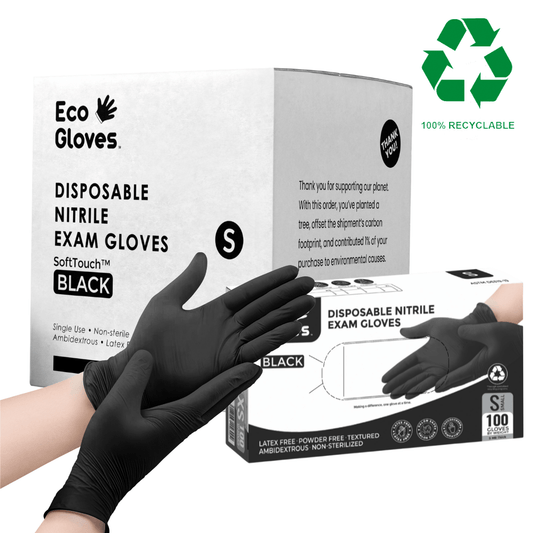Understanding Allergic Reactions to Disposable Gloves and How to Choose the Best Gloves for Skin Sensitivities
Eco GlovesDisposable gloves play a crucial role in maintaining hygiene and safety across various industries, from healthcare to foodservice and beyond. However, for individuals with sensitive skin or allergies, the wrong type of glove can lead to discomfort, skin irritation, or even severe allergic reactions. In this comprehensive guide, we’ll explore the causes of glove-related allergies, discuss the best types of gloves for sensitive skin, and offer practical tips to help prevent adverse reactions. If you’re seeking to find the right gloves that minimize irritation, read on.
Topics Covered
- What Causes Allergic Reactions to Disposable Gloves?
- Types of Gloves That Are Safe for Sensitive Skin
- How to Prevent Allergic Reactions When Wearing Disposable Gloves
- Key Takeaways: Understanding Allergic Reactions to Disposable Gloves and Choosing the Best Gloves for Skin Sensitivities
-
Frequently Asked Questions (FAQs)
What Causes Allergic Reactions to Disposable Gloves?
Allergic reactions to disposable gloves are more common than many realize. They can be caused by various factors, including the glove material, chemicals used in manufacturing, and even how the gloves are worn. Here are some of the primary causes:
1. Latex Allergy
Latex allergies are the most common cause of allergic reactions to disposable gloves. Latex is a natural rubber derived from the sap of rubber trees, and while it is an effective barrier material, it contains proteins that can trigger immune responses in sensitive individuals. According to the National Library of Medicine, about 4-9% of the general population is affected by latex allergies. This percentage increases dramatically in healthcare settings, where approximately 10-17% of healthcare workers report having a latex sensitivity due to repeated exposure. While there are guides on latex allergy prevention, it’s important to be aware of the symptoms in order to quickly act.
Symptoms: Reactions can range from mild, such as skin redness and itching, to severe, including anaphylactic shock. Immediate symptoms often include hives, runny nose, and breathing difficulties, which can escalate quickly.
2. Chemical Sensitivities (Accelerator Allergies)
Even if the glove material itself doesn’t cause an allergic reaction, chemicals used during the manufacturing process can. These chemicals, known as accelerators, are added to strengthen the material and quicken the production process. Common accelerators include thiurams, carbamates, and mercaptobenzothiazoles (MBTs). For those sensitive to these compounds, even small residual amounts can cause allergic contact dermatitis. Though rare, approximately 1% of the population may experience reactions to these chemicals.
Symptoms: Typically include itching, redness, and rashes that may develop several hours or days after exposure.
3. Powder-Related Irritations
In the past, powdered gloves were popular due to their ease of donning and removal. The powder, usually cornstarch, helps absorb moisture and makes the gloves less sticky. However, this powder can cause skin irritation and dryness. Worse, in the case of latex gloves, the powder can carry latex proteins into the air, increasing the risk of inhalation allergies. As a result, the FDA banned powdered medical gloves in 2017 due to their potential health risks.
Symptoms: Powdered gloves, especially those made from latex, can lead to a variety of symptoms due to the presence of cornstarch powder and potential airborne allergens. Common symptoms include: Skin irritation and dryness, redness and inflammation, respiratory issues, eye Irritation.
4. Improper Glove Fit and Use
Wearing gloves that don’t fit properly can also lead to skin issues. Tight gloves can cause friction, trapping moisture and body heat, while loose gloves may result in chafing. Additionally, wearing gloves for extended periods can lead to the growth of bacteria and fungi, as moisture accumulates inside the glove.
Symptoms: These conditions often lead to dry, cracked skin, redness, and itchy, painful sores. Though not a true allergic reaction, it can still cause significant discomfort and be mistaken for one.
Types of Gloves That Are Safe for Sensitive Skin
Selecting the right gloves can make a significant difference for those who experience allergic reactions. Let’s examine some of the best types of gloves available for individuals with sensitive skin:
1. Nitrile Gloves
Nitrile gloves are an excellent alternative to latex. Made from synthetic rubber, nitrile gloves are completely free of natural rubber proteins, which makes them safe for people with latex allergies. Nitrile gloves are highly durable, resistant to punctures, and chemically resistant, making them suitable for a variety of tasks.
Best for: Healthcare, food handling, industrial use. Latex-free and accelerator-free versions are available, providing an even safer option for those with chemical sensitivities.
2. Vinyl Gloves
Vinyl gloves are made from polyvinyl chloride (PVC) and are entirely latex-free. While they don’t provide the same level of durability as nitrile, they are a cost-effective solution for light-duty tasks. Vinyl gloves also avoid the use of chemical accelerators, making them a safer option for individuals with skin sensitivities.
Best for: Foodservice, cleaning, and tasks that don’t require high durability. Chemical-free and latex-free.
3. Polyethylene (PE) Gloves
These gloves are often found in food preparation settings. They are lightweight, inexpensive, and easy to use. PE gloves are ideal for single-use applications and do not contain latex or other allergens. However, they are not very durable and are not suitable for tasks requiring precision.
Best for: Short-term food handling. Latex-free, accelerator-free.
4. Accelerator-Free Gloves
Some manufacturers now produce accelerator-free nitrile gloves specifically designed for people with chemical sensitivities. By eliminating the chemical accelerators, these gloves significantly reduce the risk of allergic contact dermatitis.
Best for: Medical and laboratory environments where glove use is prolonged. Latex-free, powder-free, chemical-free.
5. Hybrid Gloves
These are blends of materials, such as nitrile and vinyl, aiming to combine the benefits of both. Hybrid gloves can be a good middle-ground option for users seeking a balance of cost, comfort, and allergy-free features.
Best for: General-purpose tasks. Latex-free.
6. Compostable Bioplastic Gloves
Compostable bioplastic gloves are a sustainable and eco-friendly option that is ideal for individuals with sensitive skin. These gloves are made from plant-based materials, such as PLA (polylactic acid) and PBAT (polybutylene adipate terephthalate), which decompose under composting conditions, leaving minimal environmental impact. Compostable gloves are free from natural rubber proteins, making them suitable for those with latex allergies. They are also typically manufactured without the use of harsh chemical accelerators, reducing the risk of allergic contact dermatitis.
Best for: Food handling, light cleaning, and tasks where sustainability is a priority. Latex-free, accelerator-free, and biodegradable.
How to Prevent Allergic Reactions When Wearing Disposable Gloves
Even when using the right gloves, additional measures can help prevent skin irritation and allergic reactions. Here are a few tips to minimize the risk:
1. Opt for Latex-Free, Powder-Free Gloves
For individuals prone to allergies, latex-free and powder-free gloves are often the safest choice. Powdered latex gloves can release airborne allergens, which can be particularly harmful in settings like hospitals. Choosing latex-free gloves like nitrile or vinyl reduces this risk significantly.
2. Change Gloves Regularly
Wearing the same pair of gloves for an extended period increases the likelihood of skin irritation. The CDC recommends changing gloves at least every hour to reduce moisture buildup, which can harbor bacteria and irritants . Regular glove changes ensure that sweat and other moisture do not accumulate, thereby reducing the risk of skin conditions.
3. Use Properly Fitting Gloves
Wearing gloves that are too tight or too loose can lead to friction and chafing. Gloves that fit well are less likely to cause irritation. Take accurate hand measurements and choose gloves accordingly to ensure they fit snugly but comfortably.
4. Wash and Moisturize Hands Frequently
After removing gloves, it’s essential to wash your hands with a gentle, hypoallergenic soap. This will help to remove any lingering allergens or irritants. Follow up with a moisturizer to keep your skin hydrated and prevent dryness.
5. Consider Using Barrier Creams
Barrier creams can form a protective layer on your skin, reducing direct contact with allergens. Applying these creams before putting on gloves may help prevent skin irritation.
6. Rotate Between Different Glove Types
Rotating between glove materials, such as switching between nitrile and vinyl, can reduce the likelihood of overexposure to a single material, thereby minimizing skin reactions.
Allergic reactions to disposable gloves are an important consideration for many people across various industries. By choosing the right type of glove, ensuring proper glove hygiene, and following the preventative tips listed above, you can reduce the likelihood of skin irritation and keep your hands comfortable and protected.
For those who prioritize comfort and safety, nitrile gloves, accelerator-free options, and vinyl gloves provide reliable solutions across many applications. Make sure to assess your workplace requirements and personal sensitivities when selecting the most appropriate glove for your needs.
Key Takeaways: Understanding Allergic Reactions to Disposable Gloves and Choosing the Best Gloves for Skin Sensitivities
-
Glove Allergies Have Multiple Causes: Reactions can stem from latex proteins, chemical accelerators, powder, improper fit, and prolonged wear.
-
Latex-Free Options Reduce Risk: Nitrile, vinyl, polyethylene (PE), and compostable bioplastic gloves are safer alternatives for sensitive skin.
-
Accelerator-Free Gloves Prevent Contact Dermatitis: Specially made nitrile gloves without chemical accelerators help avoid allergic reactions.
-
Material Choice Matters: Selecting the right glove material ensures both protection and comfort while minimizing irritation.
-
Prevention is Key: Changing gloves regularly, using proper fit, washing and moisturizing hands, and applying barrier creams can reduce irritation.
-
Eco-Friendly Options Are Available: Compostable bioplastic gloves are latex-free, chemical-free, and better for the environment, offering both sustainability and skin safety.
👉 Choosing the right disposable gloves for sensitive skin isn’t just about comfort—it’s about protecting your health, maintaining hygiene, and supporting sustainable practices.
Frequently Asked Questions (FAQs)
-
What are the most common causes of allergic reactions to disposable gloves?
A: Common causes include latex proteins, chemical accelerators, powder residues, and irritation from improper glove fit or extended wear.
-
Which disposable gloves are safest for sensitive skin?
A: Nitrile, vinyl, PE, accelerator-free nitrile, and compostable bioplastic gloves are all latex-free and generally safer for sensitive skin.
-
Can compostable gloves help prevent allergic reactions?
A: Yes. Compostable gloves are typically made from plant-based materials, are latex-free, and often manufactured without harsh chemical accelerators, reducing the risk of irritation.
-
How can I prevent skin irritation when wearing gloves?
A: Choose latex-free, powder-free gloves, ensure proper fit, change gloves regularly, wash and moisturize hands after use, and consider barrier creams.
-
Are powder-free gloves better for sensitive skin?
A: Yes. Powder-free gloves eliminate cornstarch residues that can dry out skin and reduce airborne allergens, making them a better choice for sensitive users.
Related Reading
- How To Prevent Allergic Reactions When Using Disposable Gloves
- How to Choose the Best Disposable Gloves for Cleaning
- Disposable Gloves For Industrial Use: Protecting Workers From Hazards


















